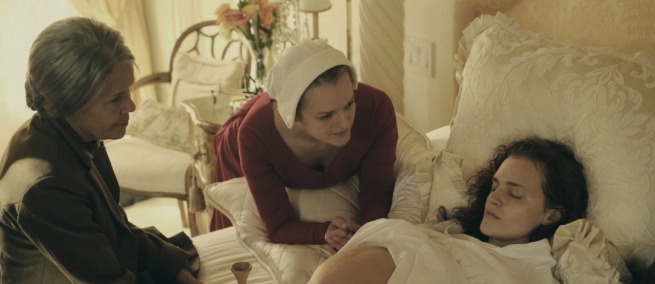
[Editor’s Note: The Hulu adaptation of Margaret Atwood’s novel The Handmaid’s Tale is now streaming, and has already been renewed for a second season. Elisabeth Moss stars as Offred, a surrogate or Handmaid to an infertile couple (played by Joseph Fiennes and Yvonne Strahovski). Sloan Science & Film commissioned a piece from infertility specialist Dr. Paula Amato, which she co-authored with reproductive medicine legal scholar Judith Daar.]
The small screen revival of Margaret Atwood’s dystopic vision of assisted reproduction in The Handmaid’s Tale gives verdure to contemporary critiques of a branch of medicine that has aided in family formation for millions of people worldwide. In the television series, as in the 1985 novel, the subjugation and assault on protagonist Offred is set in the context of a post-apocalyptic world where infertility reigns and the few fertile females are forced to serve as incubators for the newly empowered class of overseers. While terribly (and intentionally) disturbing in its own right, the plot is often evoked as a cautionary tale about the modern use of assisted reproductive technologies (ART). Today’s egg donors and gestational carriers, some lament, are equally conscripted to supply their reproductive goods and services to an upper class whose instrumentalism overtakes their humanity.

The real-life state of the nation’s fertility is hardly utopian, but any resemblance to Atwood’s bleak and nefarious portrayal is pure fiction. According to the Centers for Disease Control and Prevention (CDC), one in eight couples have difficulty conceiving or carrying a pregnancy to term. The good news is that safe and effective treatments are available, ranging from corrective surgeries to medical therapy to in vitro fertilization (IVF). Each year, some 450 fertility clinics in the U.S. perform approximately 200,000 cycles of IVF, resulting in the birth of over 70,000 infants annually. Birth rates attributable to IVF have gained steadily in the U.S., now accounting for 1.8% of all infants born in this country. Reproduction via IVF far exceeds the number of families formed through neonatal adoption, making ART a significant medical and social institution.
Perhaps the most dystopian aspect of ART is its cost and accompanying inaccessibility to many who could benefit from fertility treatment. On average, a single cycle of IVF costs upwards of $15,000 and is rarely covered by a patient’s health insurance. A handful of states do mandate that insurance companies offering policies in the jurisdiction include fertility treatment in the package of benefits, but 85% of Americans have no such access to covered care. As a result, stories of voluntary impoverishment and internet crowd funding are common, but have sadly produced little movement in the legislative arena to address this common and difficult medical issue. In contrast, countries in which IVF is a covered treatment under the national health service, treatment seeking and utilization is far greater, increasing ART births threefold compared to the U.S. As would be expected, multiple births and their accompanying obstetric and neonatal complications are also less common where coverage is provided, as patients are relieved of the financial pressure to seek transfer of more embryos than is medically indicated.

The epidemic infertility imagined in THE HANDMAID'S TALE deviates from epidemiologic facts in several ways. First, the scourge seems to have afflicted only the women who survived the apocalypse. In fact, infertility is a gender neutral disease, attributed about equally to female factors such as disorder of ovulation and tubal disease, male factors such as genetic disease and low sperm count sperm, and factors of unknown etiology. According to the CDC, in 35% of couples with infertility a male factor is identified along with a female factor. Second, Atwood’s story fails to regard infertility as a disease with effective treatments, but rather as a social stigma best addressed by forcing women who have previously given birth to serve as concubines for married men whose wives are infertile. The coercion, lack of consent, and thieving on display are shameful but bear no relation to today’s arrangements in which gestational carriers and egg donors offer services and receive compensation for aiding in another’s procreative plan. According to recent figures, around one in ten IVF cycles involves donor eggs, a necessity for same-sex male couples and women who lack the capacity to produce viable oocytes because of disease, advanced age, surgery, or gonadotoxic treatment for cancer. Gestational carriers are likewise essential to male couples and women whose uterus is absent or nonfunctional. In the main, third party reproduction proceeds without incident, inuring to the benefit of both purveyors and recipients of these life-giving contributions.
Even while providing overall benefit, third party reproduction does pose challenges that have and will continue to vex its participants. Gestational surrogacy arrangements are prohibitively expensive, costing upwards of $150,000 for the would-be intended parents. The globalization of the practice has recently taken a difficult turn, with a number of countries abruptly banning commercial exchanges and leaving hundreds of pregnant carriers and intended parents in legal limbo. Egg donation has soared in volume owing to evolving egg banking techniques and enterprises, but questions about disclosure to offspring, batch sharing, and future dispositional control over frozen material loom large as science characteristically outpaces law and ethics.
In the face of these and other challenges, it is vital to understand how and why fertility treatment is essential to our nation’s health. Infertility has important public health implications. The inability to conceive may serve as a marker of health and provides a window of opportunity to improve care for adults and children. Public health efforts can help reduce risk factors such as STDs, obesity, and smoking and improve surveillance to identify and address racial and geographic disparities in both risk factors and access to treatment. Women should be better informed regarding the risks of increased maternal age and public policy must provide women the opportunity to plan their pregnancies without sacrificing career goals.
While fictional to its core, THE HANDMAID'S TALE does provide enlightenment as to the age-old struggle that women face in controlling their reproductive lives. Aspirationally, the World Health Organization (WHO) avers that reproductive rights rest on the recognition of the basic right of all couples and individuals to decide freely and responsibly the number, spacing, and timing of their children. WHO further advocates for the right to the highest standard of sexual and reproductive health, and the right of all to make decisions concerning reproduction free of discrimination, coercion, and violence.
Reproductive rights are important to women’s socioeconomic well-being and overall health. Though tragically unavailing for Offred, THE HANDMAID'S TALE serves as a reminder that reproductive rights should be fiercely protected for the sake of women’s health and society in general.
TOPICS